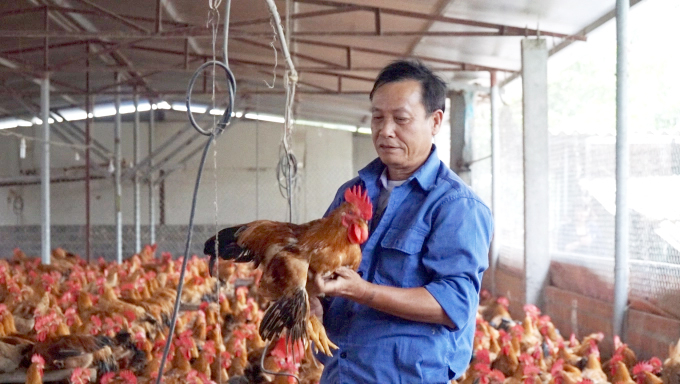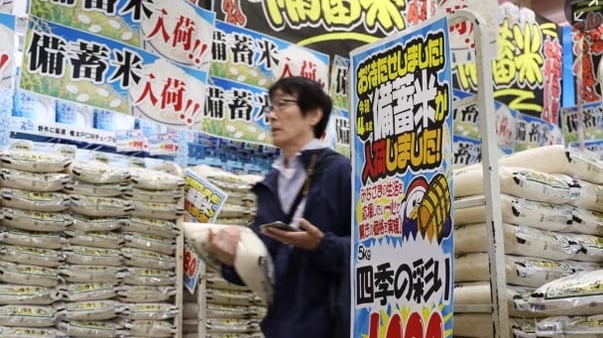June 20, 2025 | 21:14 GMT +7
June 20, 2025 | 21:14 GMT +7
Hotline: 0913.378.918
June 20, 2025 | 21:14 GMT +7
Hotline: 0913.378.918

Pham Van Nhi, a breeder at his chicken farm under VietGAHP model in Hai Phong City. Photo: Dinh Muoi.
HAI PHONG - Livestock breeding under the VietGAHP model will create sustainable values for the products, a forum has heard.
The statement was confirmed by a leader from the National Centre for Agriculture Promotion (NCAP) under the Ministry of Agriculture and Rural Development, at the forum titled “Development of Poultry Breeding Associated with Consumption” in the Red River Delta.
The forum on agriculture and agricultural development held on October 30 in the northern city of Hai Phong, is aimed to find solutions for farmers in the Red River Delta provinces to boost their livestock breeding meeting the VietGAHP standards, and develop their product consumption links.
More than 200 delegates participated in the forum, including those from the NCAP and livestock breeders from provinces of Thai Binh, Hai Duong, Ha Nam, Vinh Phuc, and Hai Phong City.
Many issues related to VietGAHP poultry raising associated with the chain of product consumption had been openly discussed at the forum.

Leaders of the National Center for Agricultural Promotion and experts answer questions of breeders at the forum. Photo: Dinh Muoi.
Deputy Director of the NCAP, Ha Thuy Hanh, said breeding orientation according to VietGAHP was very important to help farmers not only conduct their works in a correct process and ensure biosafety but also record most basically all the problems for traceability.
“When people pay more attention to breeding, their works will be more effective. First, diseases will be reduced. Second, they will be granted VietGAHP certification which can surely value and solve the matter of traceability of the product's origin,” said Hanh.
The official appealed for more connection among farmers saying it is needed for reducing the input costs and have offtake contracts with slaughter and processing enterprises thus creating sustainable values.
Pham Van Nhi, a chickens breeder is practicing the VietGAHP model on their farm with about 5,000 chicken, in Hong Phong Commune, An Duong District, Hai Phong City.
Nhi said his family was participating in a project launched by the NCAP on building a trading model of breeding chickens under the VietGAHP associated with consumption in the Red River Delta provinces in 2019.
“Thanks to the project, my family is now no longer worried about the output for the products since their value has been raising. We know more about how to apply breeding techniques in the correct way,” said Nhi.
The farmer added that after joining the project, his household was connected to a company in the area thus he had signed a product consumption contract with the selling price always equal or VND500/kg higher than the market price.
According to the NCAP, from 2018 to 2020, the center has implemented many major projects related to poultry farming under the VietGAHP model. The breeders participating in the project have stably found their product consumption at higher prices than others outside the model.
Author: Dinh Muoi. Translated by Van Trang. Edited by Duc Huy.

(VAN) Last week, the U.S. Department of Agriculture (USDA) released its June World Agricultural Supply and Demand Estimates (WASDE), raising projections for both Indian rice production and U.S. rice imports for the 2025/2026 marketing year.
/2025/06/17/2344-1-131758_261.jpg)
(VAN) Amid tariff risks and growing trade barriers in the U.S. market, Australia is emerging as a promising destination to sustain the growth momentum of Vietnam's shrimp exports.
/2025/06/17/2013-1-nongnghiep-112009.jpg)
(VAN) This notable growth trend reflects the global taste for fresh, nutritious fruits and the expanding use of lychees across various sectors.

(VAN) The political and cultural insulation of Japan’s beloved grain is falling apart, and experts warn the country’s relationship with the staple will have to adapt.

(VAN) Noting risks, report examines impacts of avian influenza, changing trade patterns since 2022, fish fraud, and shipping industry’s net-zero goals.

(VAN) Mr. Tran Quang Bao, General Director of the Forestry and Forest Protection Department, met and worked with the International Wood Products Association to promote cooperation in the field of timber trade.

(VAN) China's outbound shipments of rare earths in May jumped 23% on the month to their highest in a year, though Beijing's export curbs on some of the critical minerals halted some overseas sales.